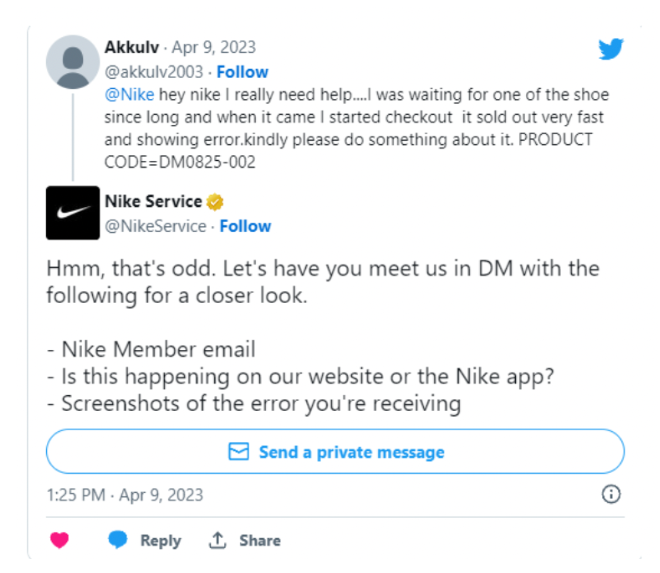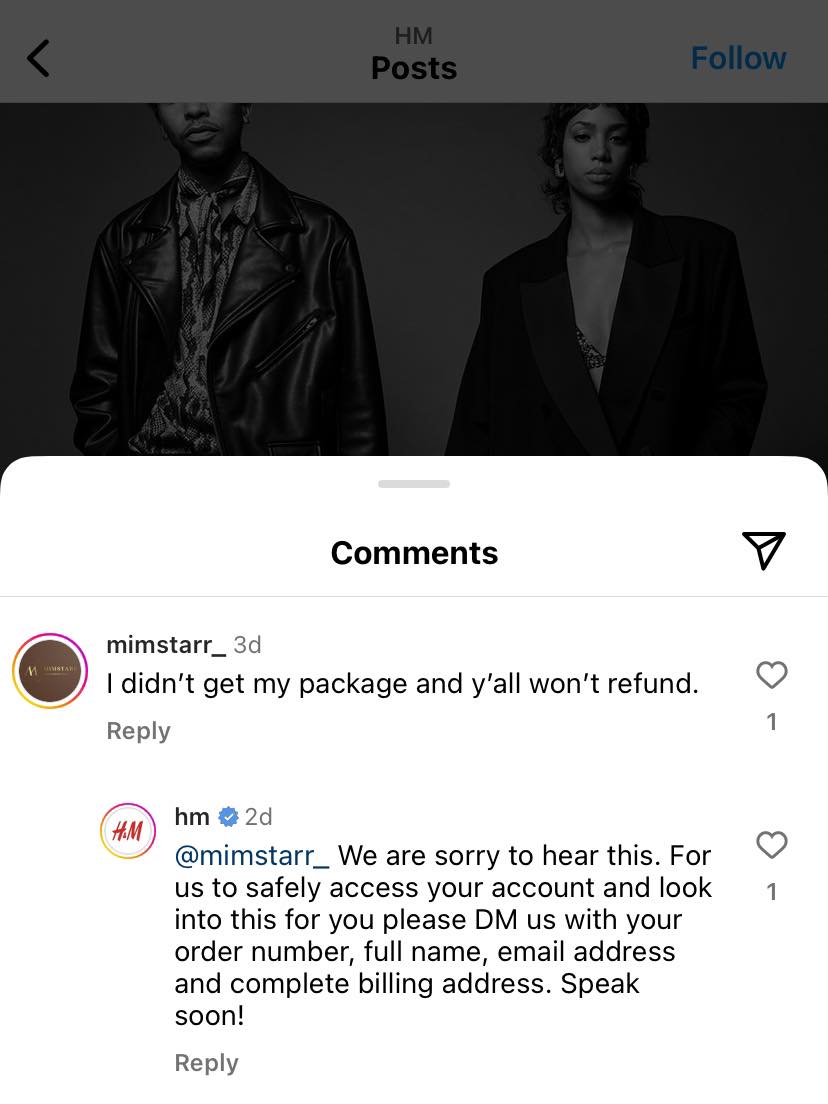
Reputation Management Examples for Local Service Businesses
Let’s take a look at something every local business owner needs to ace—reputation management. It’s not just a buzzword; it’s the secret ingredient that makes your business stand out online. In this guide, we’ll keep it real with some actual reputation management examples. We hope you’re taking notes.
Automatically request reviews to amplify your online reputation
Positive Reputation Management Examples
Customer Engagement and Responses
Quick responses and friendly, helpful advice—it’s like talking to a friend who knows their stuff. That’s how you build trust. Think about businesses like Nike and Zoom. They aren’t just about selling; they’re really into communication and supporting their customers online.
(Source: Twitter)
In the case of Zoom, they approach engagement in a few different ways. They stick to a sleek professional image on platforms like Instagram and Facebook, sharing regular “Pro Tips” to help users get the most out of the video conferencing platform. But we can’t help but notice how they apply a more laid-back and relatable attitude on TikTok.
Zoom recognizes the importance of adding a touch of fun to people’s lives. Since the pandemic, the brand has actively participated on TikTok, embracing the platform’s lively nature with younger audiences. They consistently share entertaining content, including humorous tips and tricks for using the platform and playful memes that highlight the lighter side of online meetings.
(Source, TikTok)
Transparency in Communication
When it comes to public image, honesty is the best policy. In the case of Samsung, they faced some pretty big issues in 2016. A number of Galaxy Note 7 phones began to explode due to a faulty battery, leading to a decline in sales and an airport ban (SmartSheet).
Samsung responded swiftly by taking responsibility, openly admitting that they were not sure of the root cause, and committing to finding a solution. With the help of 700 engineers and collaboration with external parties, the problem was identified and communicated transparently.
Samsung implemented quality assurance measures, launched a campaign to align its brand with a larger purpose, and made real efforts to improve its corporate culture. As a result, Samsung’s brand value increased by 9 percent the following year, according to Interbrand, and the Galaxy S8 achieved record profits.
Proactive Online Presence
Proactive reputation management involves ongoing strategies to shape, enhance, and uphold your brand’s reputation. Ideally, these tactics should be initiated early on, offering businesses several key benefits:
- Attracting More Customers: Drawing in a larger customer base.
- Building and Strengthening Brand Loyalty: Fostering stronger connections with your audience.
- Enhancing Your Online Reputation: Ensuring a positive and impactful online presence.
- Increasing Conversion Rates: Boosting the likelihood of converting leads into customers.
These strategies are designed to consistently earn the trust of your customers, demonstrating that you genuinely value them.
A compelling example of proactive reputation management is Chewy, an online pet supply company. Their poignant and empathetic responses to customers who have experienced the loss of a pet truly showcase the power of these proactive measures.
In one instance, in an article published by People Magazine, a customer approached Chewy to cancel their auto-shipping for pet food due to the passing of their beloved furry friend. The representative not only assisted with the process but also dedicated time to letting the customer share memories of their dog, Zeo, with them. Chewy goes the extra mile by sending handwritten cards and flowers to grieving pet owners, making cancellation processes and refunds seamless and compassionate.
(Source, People)
Case Studies of Reputation Recovery
Addressing Negative Reviews
Nobody is perfect, and even multi-million-dollar brands can make mistakes. H&M, one of the most influential clothing brands in the world, has its fair share of not-so-great reviews and comments online, but instead of getting down, it works hard to turn things around. Listening to customers and making things right—that’s the ticket to customer retention.
In this example, a customer is unhappy that their order never arrived. Instead of sitting idly by, H&M sought to investigate and asked to take the conversation to a DM.
(Source, Instagram)
It’s pretty uncommon to completely turn around a customer’s bad experience with just one simple reply online. In fact, trying to fix everything in a single comment can sometimes do more harm than good.
A better idea is to suggest taking the conversation offline, as H&M did here. Throw in some contact information—maybe the name of someone from our team. This not only shows you’re open to feedback but also makes you look more like a real person, not just a company. It also proves you take customer service seriously enough to have someone dedicated to dealing with issues.
Also see:
- How to Respond to Negative Online Reviews
- How to Respond to a Negative or Bad Review on Facebook
- What to Do About a Bad Google Review
Crisis Management
When something goes wrong, tell people about it quickly and always keep them in the loop. If you’re not sure how often to notify users, it’s better to communicate too much than too little.
For example, in 2018, KFC had a big problem in the U.K. After they switched delivery companies, they experienced supply chain issues, and suddenly, there wasn’t enough chicken for most of their restaurants. As a result, they had to close two-thirds of their stores (SmartSheet).
Even though the people in charge didn’t initially know the root cause, they quickly told their loyal customers what was happening, how they were working to fix it, and when the problem should be resolved.
A spokesperson for KFC said, “Our approach was to address the issue transparently: a chicken restaurant without chicken is far from ideal. We maintained real-time communication as new information unfolded. Our swift assessment and strategic approach were key to resolving the issue effectively.”
What These Brands Did Well
In analyzing the successes of these prominent brands, several strategies emerge as key to maintaining a positive online reputation:
1. Prompt and Engaging Responses
One common thread among these brands is their commitment to providing swift and thoughtful responses to customer inquiries and complaints. Whether it’s Nike’s engaging communication or Zoom’s tailored “Pro Tips,” acknowledging and addressing customer interactions promptly fosters a sense of connection and trust.
2. Proactive Approach
Championed by industry leaders like Chewy, the adoption of proactive reputation management strategies stands out. By initiating efforts early on, businesses can attract a broader customer base, strengthen brand loyalty, and ensure a positive online presence. Chewy’s empathetic responses to pet loss instances exemplify the power of proactive measures in building lasting customer relationships.
3. Honesty and Transparency
Samsung’s crisis management in the face of the Galaxy Note 7 incident illustrates the significance of honesty and transparency. Admitting uncertainty, collaborating with external parties, and implementing quality assurance measures showcased a commitment to openness, leading to increased brand value.
4. Turning Challenges into Opportunities
H&M’s approach to negative reviews highlights a practical strategy—transforming challenges into opportunities for customer retention. By actively addressing concerns, brands can resolve buyers’ problems and strengthen customer loyalty.
5. Swift Crisis Communication
KFC’s response to a supply chain issue underscores the importance of swift and transparent crisis communication. Keeping customers informed about the situation and the steps being taken ensures transparency and builds trust during a challenging time.
In a nutshell, the success of these brands stems from a combination of responsiveness, proactivity, transparency, and turning challenges into opportunities—a holistic approach that contributes to their glowing online reputation.
Considerations in Reputation Management for Local Service Businesses
Looking at these examples, some common themes stand out. Talk to your customers like they’re human, be open and honest when things get tricky, and keep the good vibes going however you can.
Reputation management is not a one-size-fits-all concept; it takes time to find what works for your unique business. On top of that, building a rep isn’t an overnight thing. It’s a journey. Take tips from these brands, tweak them for your local business, and get ready to see the fruits of your labor.
How Broadly Boosts Your Online Reputation
Ready to level up your online reputation? Check out what Broadly can do for your business by scheduling a demo with us today.
Transform your local business with revolutionary AI-powered software



